engine PONTIAC G6 2010 Owner's Manual
[x] Cancel search | Manufacturer: PONTIAC, Model Year: 2010, Model line: G6, Model: PONTIAC G6 2010Pages: 448, PDF Size: 2.5 MB
Page 133 of 448

The odometer display on the instrument panel cluster
will change from vehicle mileage to the letter M,
for manual shift mode, and a number indicating the
requested gear range when moving the shift lever
forward or rearward. SeeSpeedometer and Odometer
on page 4-26for more information.
While using the MSM feature the vehicle will have firmer
shifting and sportier performance. You can use this
for sport driving or when climbing hills to stay in gear
longer or to downshift for more power or engine braking.
The transmission will only allow you to shift into gears
appropriate for the vehicle speed and engine revolutions
per minute (RPM):
•The transmission will not shift to the next higher
gear if the engine RPM is too low.
•The transmission will not allow shifting to the next
lower gear if the engine RPM is too high.
If the vehicle does not respond to a gear change, or
detects a problem with the transmission, the range
of gears may be reduced and the Malfunction Indicator
Lamp will come on. SeeMalfunction Indicator Lamp
on page 4-34for more information.
Driver Shift Control (DSC) (If Equipped)
To use this feature,
1. Move the shift lever from DRIVE (D) rearward to
MANUAL (M).
While driving in manual mode, the transmission will
remain in the driver selected gear. When coming
to a stop in the manual position, the vehicle
will automatically shift into FIRST (1) gear.
2. Press the + (plus) paddle located on top of the
steering wheel controls forward to upshift, or
push the backside of the shift paddle rearward to
downshift.
3-27
Page 134 of 448

The odometer display on the instrument panel cluster
will change from the vehicle’s mileage to the letter M for
Manual Shift Mode, and a number indicating the
requested gear range when moving the shift lever
forward or rearward. SeeSpeedometer and Odometer
on page 4-26for more information.
While using the DSC feature the transmission will have
firmer shifting and sportier performance. You can
use this for sport driving or when climbing hills to stay in
gear longer or to downshift for more power or engine
braking.
The transmission will only allow you to shift into gears
appropriate for the vehicle speed and engine revolutions
per minute (RPM):
•The transmission will not automatically shift to the
next higher gear if the vehicle speed or engine
RPM is too high.
•The transmission will not allow shifting to the next
lower gear if the vehicle speed or engine RPM is
too high.
2 (Second)/3 (Third) Gear Start Feature
Notice:If you attempt a third gear start while
trailering or towing a heavy load, you will notice
reduced engine power. This could overheat
and damage your transmission. Do not attempt a
third gear start while trailering or towing your
vehicle.
Vehicles with a 6-speed transmission allow 2 (Second)
and 3 (Third) gear starts. When accelerating the
vehicle from a stop in snowy and icy conditions, you
may want to shift into 2 (Second), or 3 (Third) gear. A
higher gear, and light application of the gas pedal, may
allow you to gain more traction on slippery surfaces.
With the MSM, the vehicle can accelerate from a stop in
2 (Second) or 3 (Third).
1. Move the shift lever from D (Drive) into the
M (Manual Mode) position.
2. With the vehicle stopped, move the lever forward
towards the + (plus) to select 2 (Second) or
3 (Third) gear. The vehicle will start from a stop
position in 2 (Second) or 3 (Third) gear.
3. Once the vehicle is moving select the desired
drive gear.
3-28
Page 136 of 448

Shifting Into Park (Automatic
Transmission)
{WARNING:
It can be dangerous to get out of the vehicle if the
shift lever is not fully in P (Park) with the parking
brake firmly set. The vehicle can roll. If you have
left the engine running, the vehicle can move
suddenly. You or others could be injured. To be
sure the vehicle will not move, even when you are
on fairly level ground, use the steps that follow. If
you are pulling a trailer, seeTowing a Trailer on
page 5-27.
Use this procedure to shift into P (Park):
1. Hold the brake pedal down and set the parking
brake.
SeeParking Brake on page 3-29for more
information.
2. Move the shift lever into P (Park) by holding in the
button on the shift lever and pushing the lever all
the way toward the front of the vehicle.3. Turn the ignition key to LOCK/OFF.
4. Remove the key and take it with you. If you can
leave the vehicle with the ignition key in your
hand, the vehicle is in P (Park).
Leaving Your Vehicle With the Engine
Running
{WARNING:
It can be dangerous to leave the vehicle with the
engine running. The vehicle could move suddenly if
the shift lever is not fully in P (Park) with the parking
brake firmly set. And, if you leave the vehicle with
the engine running, it could overheat and even
catch fire. You or others could be injured. Do not
leave the vehicle with the engine running.
If you have to leave the vehicle with the engine running,
be sure the vehicle is in P (Park) and the parking
brake is firmly set before you leave it. After you have
moved the shift lever into P (Park), hold the brake pedal
down. Then, see if you can move the shift lever away
from P (Park) without first pushing the button.
If you can, it means that the shift lever was not fully
locked into P (Park).
3-30
Page 138 of 448

Parking Over Things That Burn
{WARNING:
Things that can burn could touch hot exhaust parts
under the vehicle and ignite. Do not park over
papers, leaves, dry grass, or other things that
can burn.
Engine Exhaust
{WARNING:
Engine exhaust contains Carbon Monoxide (CO)
which cannot be seen or smelled. Exposure to CO
can cause unconsciousness and even death.
Exhaust may enter the vehicle if:
•The vehicle idles in areas with poor ventilation
(parking garages, tunnels, deep snow that
may block underbody airflow or tail pipes).
•The exhaust smells or sounds strange or
different.
WARNING: (Continued)
WARNING: (Continued)
•
The exhaust system leaks due to corrosion or
damage.
•The vehicle’s exhaust system has been
modified, damaged or improperly repaired.
•There are holes or openings in the vehicle
body from damage or after-market
modifications that are not completely sealed.
If unusual fumes are detected or if it is suspected
that exhaust is coming into the vehicle:
•Drive it only with the windows
completely down.
•Have the vehicle repaired immediately.
Never park the vehicle with the engine running in
an enclosed area such as a garage or a building
that has no fresh air ventilation.
3-32
Page 139 of 448

Running the Vehicle While Parked
It is better not to park with the engine running. But if you
ever have to, here are some things to know.
{WARNING:
Idling a vehicle in an enclosed area with poor
ventilation is dangerous. Engine exhaust may
enter the vehicle. Engine exhaust contains Carbon
Monoxide (CO) which cannot be seen or smelled.
It can cause unconsciousness and even death.
Never run the engine in an enclosed area that has
no fresh air ventilation. For more information, see
Engine Exhaust on page 3-32.
{WARNING:
It can be dangerous to get out of the vehicle if the
automatic transmission shift lever is not fully in
P (Park) with the parking brake firmly set. The
vehicle can roll. Do not leave the vehicle when the
engine is running unless you have to. If you have
left the engine running, the vehicle can move
suddenly. You or others could be injured. To be
sure the vehicle will not move, even when you are
on fairly level ground, always set the parking
brake and move the shift lever to P (Park).
Follow the proper steps to be sure the vehicle will not
move. SeeShifting Into Park (Automatic Transmission)
on page 3-30.
If parking on a hill and pulling a trailer, seeTowing a
Trailer on page 5-27.
3-33
Page 144 of 448
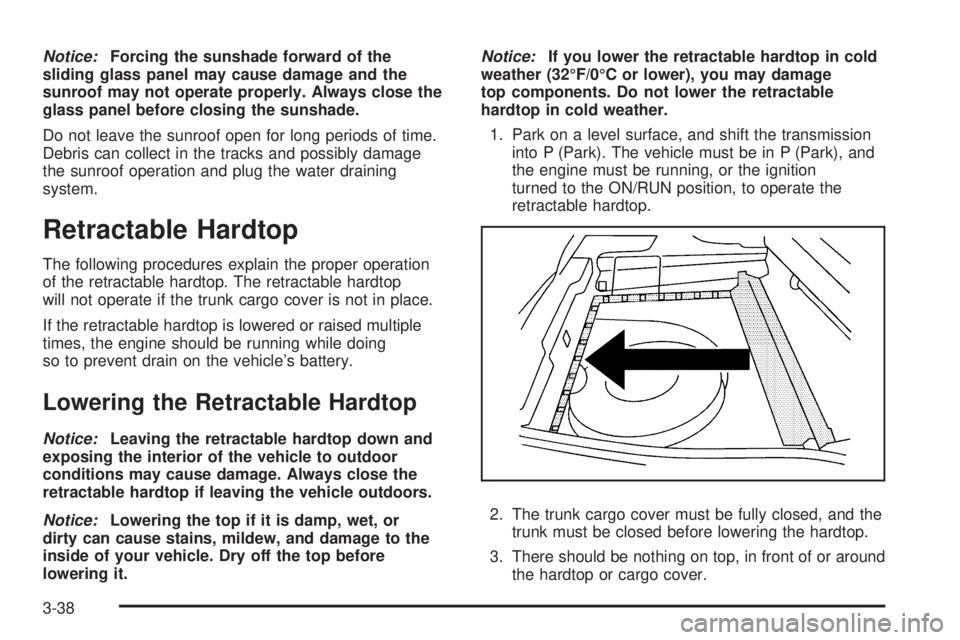
Notice:Forcing the sunshade forward of the
sliding glass panel may cause damage and the
sunroof may not operate properly. Always close the
glass panel before closing the sunshade.
Do not leave the sunroof open for long periods of time.
Debris can collect in the tracks and possibly damage
the sunroof operation and plug the water draining
system.
Retractable Hardtop
The following procedures explain the proper operation
of the retractable hardtop. The retractable hardtop
will not operate if the trunk cargo cover is not in place.
If the retractable hardtop is lowered or raised multiple
times, the engine should be running while doing
so to prevent drain on the vehicle’s battery.
Lowering the Retractable Hardtop
Notice:Leaving the retractable hardtop down and
exposing the interior of the vehicle to outdoor
conditions may cause damage. Always close the
retractable hardtop if leaving the vehicle outdoors.
Notice:Lowering the top if it is damp, wet, or
dirty can cause stains, mildew, and damage to the
inside of your vehicle. Dry off the top before
lowering it.Notice:If you lower the retractable hardtop in cold
weather (32°F/0°C or lower), you may damage
top components. Do not lower the retractable
hardtop in cold weather.
1. Park on a level surface, and shift the transmission
into P (Park). The vehicle must be in P (Park), and
the engine must be running, or the ignition
turned to the ON/RUN position, to operate the
retractable hardtop.
2. The trunk cargo cover must be fully closed, and the
trunk must be closed before lowering the hardtop.
3. There should be nothing on top, in front of or around
the hardtop or cargo cover.
3-38
Page 146 of 448
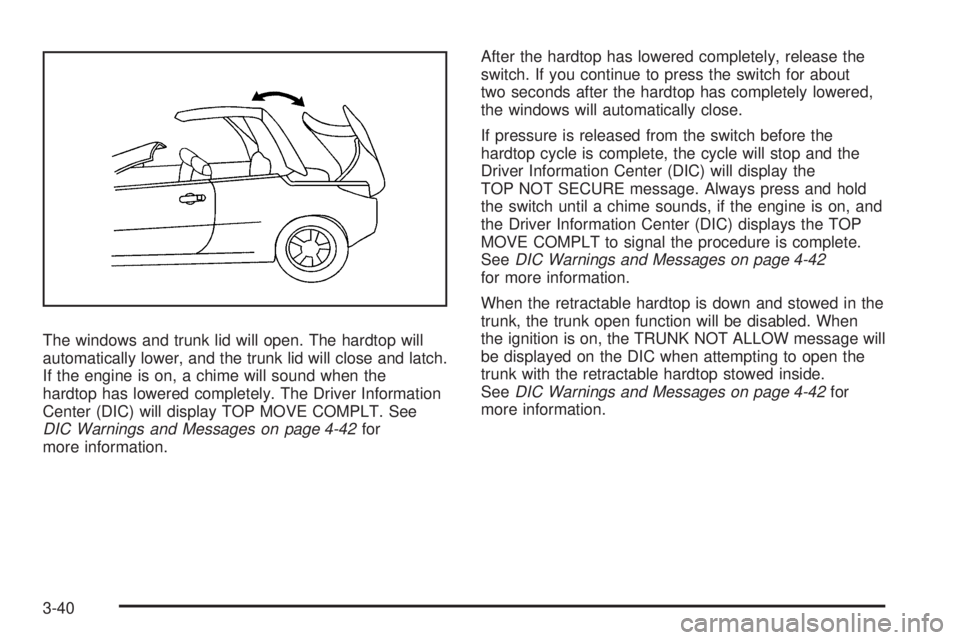
The windows and trunk lid will open. The hardtop will
automatically lower, and the trunk lid will close and latch.
If the engine is on, a chime will sound when the
hardtop has lowered completely. The Driver Information
Center (DIC) will display TOP MOVE COMPLT. See
DIC Warnings and Messages on page 4-42for
more information.After the hardtop has lowered completely, release the
switch. If you continue to press the switch for about
two seconds after the hardtop has completely lowered,
the windows will automatically close.
If pressure is released from the switch before the
hardtop cycle is complete, the cycle will stop and the
Driver Information Center (DIC) will display the
TOP NOT SECURE message. Always press and hold
the switch until a chime sounds, if the engine is on, and
the Driver Information Center (DIC) displays the TOP
MOVE COMPLT to signal the procedure is complete.
SeeDIC Warnings and Messages on page 4-42
for more information.
When the retractable hardtop is down and stowed in the
trunk, the trunk open function will be disabled. When
the ignition is on, the TRUNK NOT ALLOW message will
be displayed on the DIC when attempting to open the
trunk with the retractable hardtop stowed inside.
SeeDIC Warnings and Messages on page 4-42for
more information.
3-40
Page 147 of 448
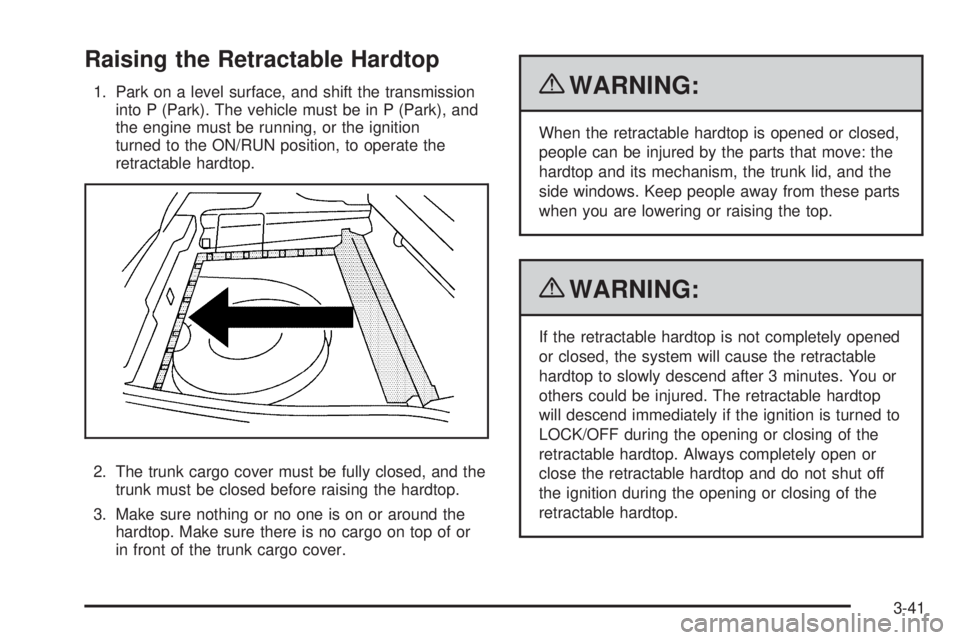
Raising the Retractable Hardtop
1. Park on a level surface, and shift the transmission
into P (Park). The vehicle must be in P (Park), and
the engine must be running, or the ignition
turned to the ON/RUN position, to operate the
retractable hardtop.
2. The trunk cargo cover must be fully closed, and the
trunk must be closed before raising the hardtop.
3. Make sure nothing or no one is on or around the
hardtop. Make sure there is no cargo on top of or
in front of the trunk cargo cover.{WARNING:
When the retractable hardtop is opened or closed,
people can be injured by the parts that move: the
hardtop and its mechanism, the trunk lid, and the
side windows. Keep people away from these parts
when you are lowering or raising the top.
{WARNING:
If the retractable hardtop is not completely opened
or closed, the system will cause the retractable
hardtop to slowly descend after 3 minutes. You or
others could be injured. The retractable hardtop
will descend immediately if the ignition is turned to
LOCK/OFF during the opening or closing of the
retractable hardtop. Always completely open or
close the retractable hardtop and do not shut off
the ignition during the opening or closing of the
retractable hardtop.
3-41
Page 148 of 448
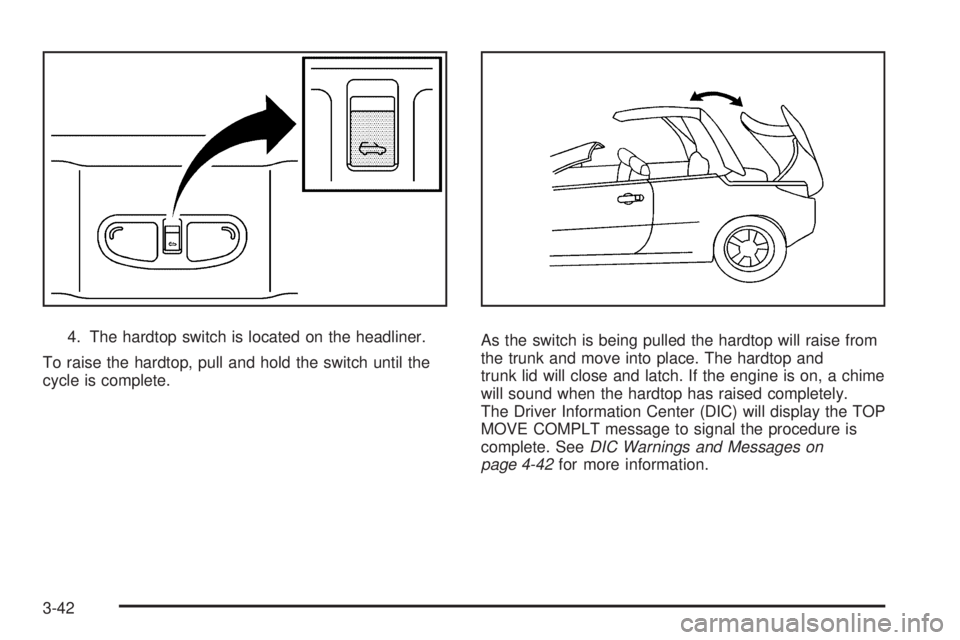
4. The hardtop switch is located on the headliner.
To raise the hardtop, pull and hold the switch until the
cycle is complete.As the switch is being pulled the hardtop will raise from
the trunk and move into place. The hardtop and
trunk lid will close and latch. If the engine is on, a chime
will sound when the hardtop has raised completely.
The Driver Information Center (DIC) will display the TOP
MOVE COMPLT message to signal the procedure is
complete. SeeDIC Warnings and Messages on
page 4-42for more information.
3-42
Page 149 of 448
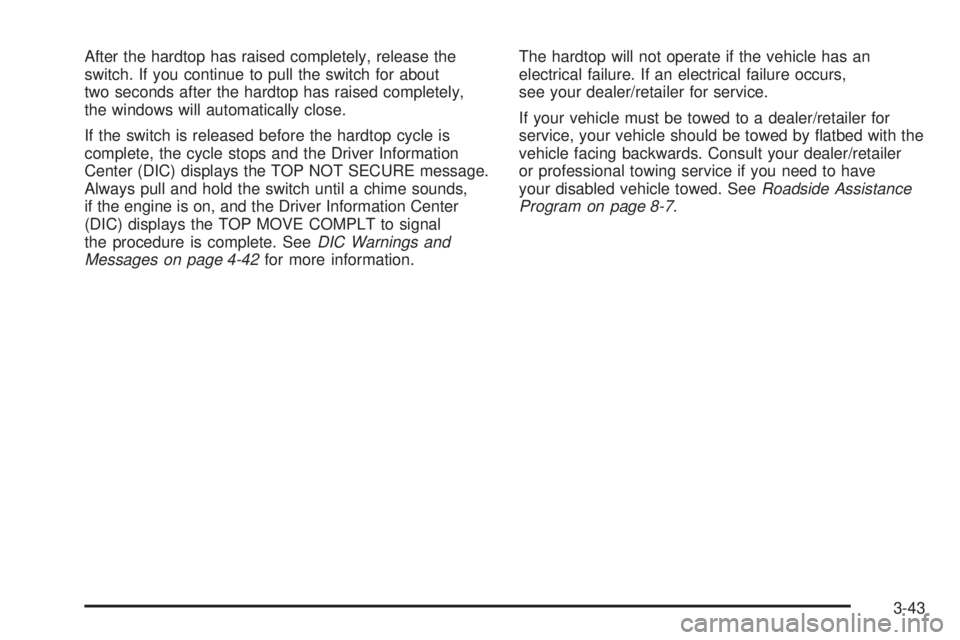
After the hardtop has raised completely, release the
switch. If you continue to pull the switch for about
two seconds after the hardtop has raised completely,
the windows will automatically close.
If the switch is released before the hardtop cycle is
complete, the cycle stops and the Driver Information
Center (DIC) displays the TOP NOT SECURE message.
Always pull and hold the switch until a chime sounds,
if the engine is on, and the Driver Information Center
(DIC) displays the TOP MOVE COMPLT to signal
the procedure is complete. SeeDIC Warnings and
Messages on page 4-42for more information.The hardtop will not operate if the vehicle has an
electrical failure. If an electrical failure occurs,
see your dealer/retailer for service.
If your vehicle must be towed to a dealer/retailer for
service, your vehicle should be towed by flatbed with the
vehicle facing backwards. Consult your dealer/retailer
or professional towing service if you need to have
your disabled vehicle towed. SeeRoadside Assistance
Program on page 8-7.
3-43